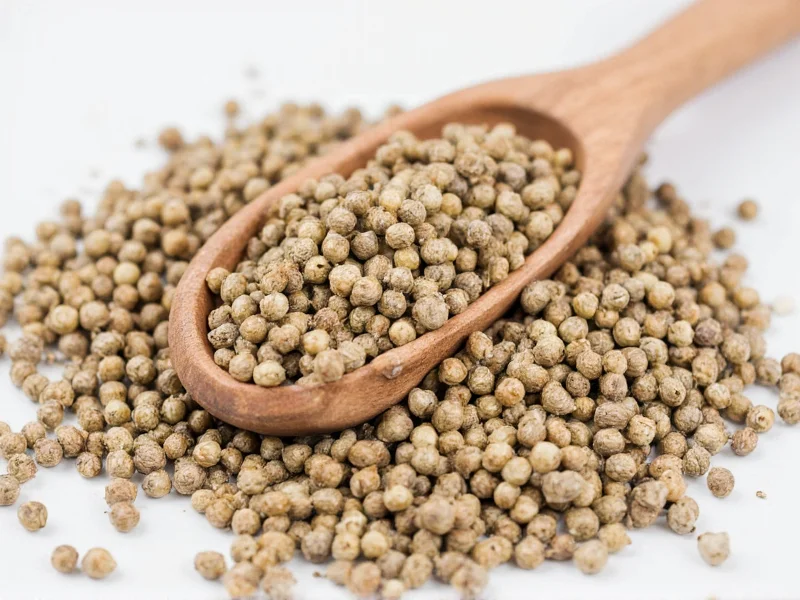Understanding White Pepper: More Than Just a Color Difference
While many home cooks treat white and black pepper as interchangeable, they're actually quite distinct spices with different production methods, flavor profiles, and culinary applications. White pepper begins as the same Piper nigrum fruit that produces black pepper, but undergoes additional processing that fundamentally changes its chemical composition and sensory characteristics.
The Production Process: How White Pepper is Made
White pepper production involves several precise steps that differentiate it from black pepper:
- Ripening: Peppercorns are allowed to fully ripen to red on the vine (unlike black pepper which is picked unripe and green)
- Fermentation: The ripe berries are soaked in water for 7-10 days, allowing natural fermentation to break down the outer fruit layer
- Removal: The softened outer layer is mechanically or manually scrubbed away
- Drying: The remaining inner seed is sun-dried until it becomes the pale beige to light tan color we recognize as white pepper
This extended processing removes many of the volatile compounds found in black pepper's outer layer, resulting in a different chemical profile and flavor experience.
White Pepper vs Black Pepper: A Detailed Comparison
Understanding the differences between these two common spices helps explain when to use white pepper versus its more popular counterpart:
| Characteristic | White Pepper | Black Pepper |
|---|---|---|
| Processing Method | Ripe berries soaked, outer layer removed, inner seed dried | Unripe green berries dried in sun (causing outer layer to turn black) |
| Flavor Profile | Earthy, musty, less floral, more pungent | Floral, citrusy notes, more complex top notes |
| Heat Level | Milder initial heat but longer-lasting pungency | Sharper initial heat that dissipates more quickly |
| Visual Impact | Blends into light-colored dishes | Creates visible black specks |
| Traditional Uses | French cuisine, Chinese cooking, light sauces, mashed potatoes | General seasoning, dark sauces, most Western applications |
Culinary Applications: When to Use White Pepper
The primary reason chefs choose white pepper over black comes down to aesthetics and specific flavor requirements. Professional kitchens often reach for white pepper in these situations:
- Light-colored dishes where black specks would be visually distracting - think béchamel sauce, mashed potatoes, white gravies, or cream soups
- Asian cuisine particularly in Chinese cooking where it's traditional in many dishes
- Delicate preparations where the floral notes of black pepper might overpower subtle flavors
- Specific flavor profiles when the earthier, mustier notes of white pepper complement other ingredients
Many professional chefs maintain both varieties in their spice collection because understanding white pepper benefits in specific applications can elevate a dish from good to exceptional.
Flavor Chemistry: Why White Pepper Tastes Different
The flavor difference between white and black pepper stems from their chemical composition. Black pepper contains higher levels of:
- Piperine (the compound responsible for heat)
- Limonene (citrus notes)
- Caryophyllene (woody, spicy notes)
White pepper, through its processing, develops higher concentrations of:
- 3-Carene (earthy, pine-like notes)
- Terpinolene (woody, floral notes)
- Various fermentation byproducts that create its distinctive mustiness
This chemical shift explains why many people describe white pepper as having a "cleaner" heat that lingers differently on the palate compared to black pepper.
Storage and Shelf Life Considerations
Like all ground spices, white pepper gradually loses potency over time. For optimal flavor:
- Store in an airtight container away from light and heat
- Whole white peppercorns maintain freshness significantly longer than pre-ground versions
- Ground white pepper typically retains peak flavor for 6-12 months
- Check for freshness by smelling - diminished aroma indicates reduced potency
Many culinary professionals recommend grinding white peppercorns fresh for critical applications, just as they would with black pepper, to maximize flavor impact.
Substitution Guidance: White Pepper Alternatives
If you're wondering about a white pepper substitute, consider these options based on your specific needs:
- For visual reasons only: Cayenne pepper (use sparingly) or white peppercorn powder can maintain color while providing heat
- For flavor approximation: A combination of black pepper and a tiny pinch of cumin can mimic some earthy notes
- For authentic Asian applications: Sichuan peppercorns (though these provide different numbing sensation)
- Best overall substitute: Freshly ground black pepper, but reduce quantity by 25-30% as white pepper is generally milder
Remember that no substitute perfectly replicates white pepper's unique profile, which is why maintaining both varieties in your spice collection provides the most culinary flexibility.











 浙公网安备
33010002000092号
浙公网安备
33010002000092号 浙B2-20120091-4
浙B2-20120091-4